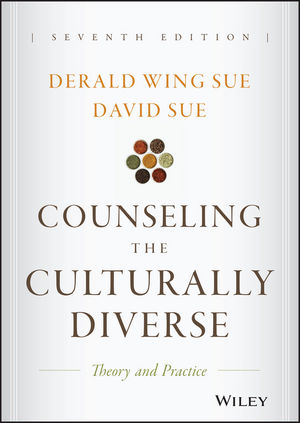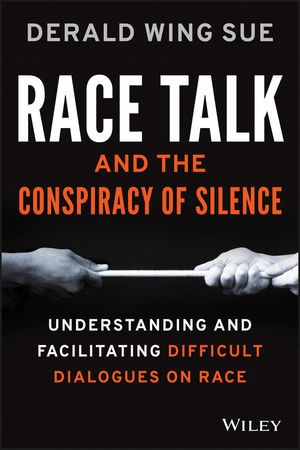Counseling the Culturally Diverse: Theory and Practice, 7th Edition
Wiley
December 2015
832 pages
7.2 x 1.7 x 9.6 inches
Hardcover ISBN-13: 978-1119084303
Derald Wing Sue, Professor of Psychology and Education
Department of Counseling and Clinical Psychology
Teachers College, Columbia University, New York, New York
David Sue, Professor Emeritus of Psychology
Western Washington University, Bellingham, Washington

The standard bearing guide for multicultural counseling courses now enhanced with research-based, topical, and pedagogical refinements
Counseling the Culturally Diverse: Theory and Practice, 7th Edition is the new update to the seminal work on multicultural counseling. From author Derald Wing Sue – one of the most cited multicultural scholars in the United States – this comprehensive work includes current research, cultural and scientific theoretical formations, and expanded exploration of internalized racism. Replete with real-world examples, this book explains why conversations revolving around racial issues remain so difficult, and provides specific techniques and advice for leading forthright and productive discussions. The new edition focuses on essential instructor and student needs to facilitate a greater course-centric focus.
In response to user feedback and newly available research, the seventh edition reflects:
- Renewed commitment to comprehensiveness. As compared to other texts in the field, CCD explores and covers nearly all major multicultural counseling topics in the profession. Indeed, reviewers believed it the most comprehensive of the texts published, and leads in coverage of microaggressions in counseling, interracial/interethnic counseling, social justice approaches to counseling, implications of indigenous healing, the sociopolitical nature of counseling, racial identity development, and cultural use of evidence-based practice.
- Streamlined Presentation to allow students more time to review and analyze rather than read more detailed text
- New advances and important changes, such as expanded coverage of internalized racism, cultural humility, expansion of microaggression coverage to other marginalized groups, social justice/advocacy skills, recent research and thinking on evidence-based practice, and new approaches to work with specific populations.
- Most current work in multicultural mental health practice including careful consideration of the multicultural guidelines proposed by the American Psychological Association and the draft guidelines for Multicultural and Social Justice Counseling Competencies (MSJCC) (2015) from the American Counseling Association’s Revision Committee.
- Expanded attention to the emotive nature of the content so that the strong emotive reaction of students to the material does not prevent self-exploration (a necessary component of cultural competence in the helping professions).
- Strengthened Pedagogy in each chapter with material to facilitate experiential activities and discussion and to help students digest the material including broad Chapter Objectives and more specific and oftentimes controversial Reflection and Discussion Questions. Every chapter opens with a clinical vignette, longer narrative, or situational example that previews the major concepts and issues discussed in the chapter. The Chapter Focus Questions serve as prompts to address the opening ‘course objectives,’ but these questions not only preview the content to be covered, but are cast in such a way as to allow instructors and trainers to use them as discussion questions throughout the course or workshop. We have retained the ‘Implications for Clinical Practice’ sections and added a new Summary after every chapter. Instructor’s Handbook has been strengthen and expanded to provide guidance on teaching the course, anticipating resistances, overcoming them, and providing exercises that could be used such as case studies, videos/movies, group activities, tours/visits, and other pedagogy that will facilitate learning.
- Easier comparison between and among groups made possible by updating population specific chapters to use common topical headings (when possible).
Offering the perfect blend of theory and practice, this classic text helps readers overcome the discomfort associated with discussions of race, provides real-world examples of how to discuss diversity and difference openly and honestly, and closely examines the hidden and unwritten rules that dictate many aspects of diversity in today’s world.
Table of Contents
- Preface
- About the Authors
- Section One the Multiple Dimensions of Multicultural Counseling and Therapy
- Part I: The Affective and Conceptual Dimensions of Multicultural Counseling and Therapy
- Chapter 1 Obstacles to Cultural Competence: Understanding Resistance to Multicultural Training
- Emotional Self-Revelations and Fears: Majority Group Members
- Emotional Invalidation versus Affirmation: For Marginalized Group Members
- A Word of Caution
- Recognizing and Understanding Resistance to Multicultural Training: For Trainees and Trainers
- Cognitive Resistance—Denial
- Emotional Resistance
- Behavioral Resistance
- Conclusions
- Summary
- References
- Chapter 2 The Superordinate Nature of Multicultural Counseling and Therapy
- Culture Universal (Etic) versus Culture Specific (Emic) Formulations
- The Nature of Multicultural Counseling Competence
- A Tripartite Framework for Understanding the Multiple Dimensions of Identity
- Individual and Universal Biases in Psychology and Mental Health
- The Impact of Group Identities on Counseling and Psychotherapy
- What Is Multicultural Counseling/Therapy?
- What Is Cultural Competence?
- Cultural Humility and Cultural Competence
- Social Justice and Cultural Competence
- Summary
- References
- Chapter 3 Multicultural Counseling Competence for Counselors and Therapists of Marginalized Groups
- Counselors from Marginalized Groups Working with Majority and Other Marginalized Group Clients
- The Politics of Interethnic and Interracial Bias and Discrimination
- The Historical and Political Relationships between Groups of Color
- Differences between Racial/Ethnic Groups
- Counselors of Color and Dyadic Combinations
- Summary
- References
- Part II The Political Dimensions of Mental Health Practice
- Chapter 4 The Political and Social Justice Implications of Counseling and Psychotherapy
- The Education and Training of Mental Health Professionals
- Definitions of Mental Health
- Counseling and Mental Health Literature
- Need to Treat Social Problems—Social Justice Counseling
- The Foci of Therapeutic Interventions: Individual, Professional, Organizational and Societal
- Social Justice Counseling
- Summary
- References
- Chapter 5 Impact of Systemic Oppression
- Therapist Credibility and Client Worldviews
- The Rest of the Story
- Therapist Credibility and Attractiveness
- Formation of Individual and Systemic Worldviews
- Formation of Worldviews
- Summary
- References
- Chapter 6 Microaggressions in Counseling and Psychotherapy
- Contemporary Forms of Oppression
- Evolution of the “Isms”: Microaggressions
- The Dynamics and Dilemmas of Microaggressions
- Therapeutic Implications
- Summary
- Part III The Practice Dimensions of Multicultural Counseling/Therapy
- Chapter 7 Barriers to Multicultural Counseling and Therapy: Individual and Family Perspectives
- Identifying Multicultural Therapeutic Issues
- Generic Characteristics of Counseling/Therapy
- Culture-Bound Values
- Class-Bound Values
- Language Barriers
- Patterns of “American” Cultural Assumptions and Multicultural Family Counseling/Therapy
- Conclusions
- Summary
- References
- Chapter 8 Culturally Appropriate Intervention Skills and Strategies
- Cultural Expression of Mental Disorders
- Communication Styles
- Sociopolitical Facets of Nonverbal Communication
- Counseling and Therapy as Communication Style
- Summary
- References
- Chapter 9 Multicultural Evidence-Based Practice
- Evidence-Based Practice and Multiculturalism
- Evidence-Based Practice and Diversity Issues in Therapy
- Summary
- References
- Chapter 10 Non-Western Indigenous Methods of Healing: Implications for Multicultural Counseling and Therapy
- Legitimacy of Culture-Bound Syndromes: Nightmare Deaths and the Hmong Sudden Death Phenomenon
- The Principles of Indigenous Healing
- Conclusion
- Summary
- References
- Part IV Racial/Cultural Identity Development in Multicultural Counseling and Therapy
- Chapter 11 Racial/Cultural Identity Development in People of Color: Therapeutic Implications
- Racial Awakening
- Racial/Cultural Identity Development Models
- A Racial/Cultural Identity Development Model
- Therapeutic Implications of the R/ CID Model
- Conclusions
- Summary
- References
- Chapter 12 White Racial Identity Development: Therapeutic Implications
- What Does It Mean to Be White?
- The Invisible Whiteness of Being
- Understanding the Dynamics of Whiteness
- Models of White Racial Identity Development
- The Process of White Racial Identity Development: A Descriptive Model
- Developing a Nonracist and Antiracist White Identity
- Summary
- Section Two Multicultural Counseling and Specific Populations
- Part V Understanding Specific Populations
- Chapter 13 Culturally Competent Assessment
- Therapist Variables Affecting Diagnosis
- Cultural Competence and Preventing Diagnostic Errors
- Contextual and Collaborative Assessment
- Infusing Cultural Competence into Standard Clinical Assessments
- References
- Part VI Counseling and Therapy with Racial/Ethnic Minority Group Populations
- Chapter 14 Counseling African Americans
- Characteristics and Strengths
- Specific Challenges
- References
- Chapter 15 Counseling American Indians and Alaska Natives
- Characteristics and Strengths
- Specific Challenges
- Alcohol and Substance Abuse
- References
- Chapter 16 Counseling Asian Americans and Pacific Islanders
- Characteristics and Strengths
- Specific Challenges
- References
- Chapter 17 Counseling Latinos
- Characteristics and Strengths
- Specific Challenges
- References
- Chapter 18 Counseling Individuals of Multiracial Descent
- Multiracialism in the United States
- Specific Challenges
- A Multiracial Bill of Rights
- Multiracial Strengths
- References
- Part VII Counseling and Special Circumstances Involving Racial/Ethnic Populations
- Chapter 19 Counseling Arab and Muslim Americans
- Arab Americans
- Muslim Americans
- Characteristics and Strengths
- Specific Challenges
- References
- Chapter 20 Counseling Jewish Americans
- Characteristics and Strengths
- Specific Challenges
- References
- Chapter 21 Counseling Immigrants and Refugees
- Challenges and Strengths
- Counseling Refugees
- References
- Part VIII Counseling and Therapy with Other Multicultural Populations
- Chapter 22 Counseling LGBT Individuals
- Understanding Sexual Minorities
- Specific Challenges
- References
- Chapter 23 Counseling Older Adult Clients
- Characteristics and Strengths
- Specific Challenges of Older Adults
- References
- Chapter 24 Counseling Women
- Specific Challenges
- Embracing Gender Strengths
- References
- Chapter 25 Counseling and Poverty
- Demographics: Who Are the Poor?
- Strengths of People Living in Poverty
- Suggested Guidelines for Counselors
- References
- Chapter 26 Counseling Persons with Disabilities
- Understanding Disabilities
- The Americans with Disabilities Act
- Specific Challenges
- Supports for Individuals with Disabilities
- Counseling Issues with Individuals with Disabilities
- References
- Author Index
- Subject Index


